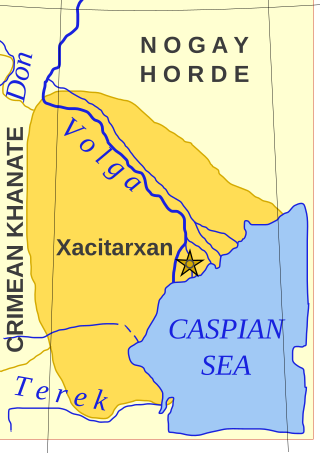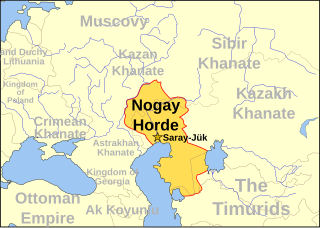This article includes a list of general references, but it lacks sufficient corresponding inline citations .(January 2025) |
| Kazakh-Nogai War 1535-1537 | |||||||
|---|---|---|---|---|---|---|---|
| |||||||
| Belligerents | |||||||
| Nogai Horde Bukhara Khanate Moghulistan | Kazakh Khanate | ||||||
| Commanders and leaders | |||||||
| Ubaidullah Khan Abdurashid Khan | Tugum Khan Tahir Khan Baush Khan | ||||||
The Kazakh-Nogai War (1535-1537) was a multilateral armed conflict in Central Asia, resulting in a crushing defeat for the Kazakh Khanate.
The Nogais, who had once been a part of the Kazakh Khanate, began to distance themselves from it and sought to assert their independence. In the 1520s, Seyit-Akhmen, a prominent leader of the Nogai-Horde, launched an invasion into Kazakh territory. This was followed in the 1530s by Sheikh Mamai and his forces, who seized control of the of the western regions of the Kazakh Khanate.[ citation needed ] [1]
The border between the Nogai Horde and the Kazakh Khanate likely ran along the Emba River. In early 1535, Moscow's envoy to the Nogai Horde, Danila Gubin, wrote to Ivan IV:[ citation needed ]
By the second quarter of the 16th century, alliances began to form against the Kazakhs, with the rulers of the Nogai-Horde, Bukhara, and Khorezm coordinating against the Kazakhs. At the same time, the Kalmyks aligned with the Kazakhs.[ citation needed ]
"And, Sovereign, the murzas wintered—Shikh Mamai Murza and Isup Murza—beyond the Yaik. And news came to Shikh Mamai Murza from the prince of Jurgen, and they say, Sovereign, that the Kazakhs are fully prepared to march against the Nogais for war. And they say, Sovereign, the Kazakhs are strong, and the Kalmyks have joined them. And Shikh Mamai, Isup, and other murzas who roam with them stand on guard beyond the Yaik on the Emba River, guarding themselves from the Kazakh Horde all winter."[ citation needed ]
However, the information received by the Nogai beks from Urgench was false. Instead of attacking the Nogais, Khan Togum directed his forces toward Tashkent. The city governor, Barak Khan (Nauruz-Ahmad Khan), suffered two battle defeats.
These successes of the Kazakh Khan caused concern among his long-time opponents. It was clear that Togum would not stop at capturing Tashkent. In the autumn of 1536, Central Asian envoys arrived to meet the Nogai rulers.[ citation needed ] According to D. Gubin, Moscow was informed:
"An envoy came to the prince and the murzas, asking the prince and murzas to march against the Kazakhs. And, Sovereign, they say that Tashkent is of great value to the Kazakhs. They expect that this summer or winter it will be taken. And, Sovereign, they say the Kazakhs are not advancing on the Nogais because they are warring over Tashkent."
As a result, the proposal for an alliance was accepted. The new coalition included the Nogai murzas, the rulers of Maverannahr, and the Mughal Khan Rashid. A joint offensive was planned for the summer of 1537. The war ended in devastating defeats for the Kazakhs, including the death of Khan Togum and 37 sultans in one battle. Nogai murza Kelmagmet wrote to Moscow stating that:
"The yurts of the Urus tsars forgot God, forgot our words, and broke their oath, and God gave them to us,"[ citation needed ]
Meanwhile, Mirza Muhammad Haidar Dughlat noted:
"Having allied with the Shaybanids, he (Rashid Khan) crushed the Uzbek-Kazakhs. Indeed, if one looks back at earlier events, it becomes clear that the defeat of the Uzbeks was a rare and remarkable occurrence. From the time Sultan Yunus Khan defeated Buruj Oghlan in Kara-Tukai in the year 877 (1472–1473), until now, many battles have taken place between the Uzbeks and the Mughals; the Uzbeks were always victorious, while the Mughals never won during this period. But Rashid Khan achieved victory over the Uzbeks, and this accomplishment of Rashid Khan stands as one of his greatest deeds." [2]








